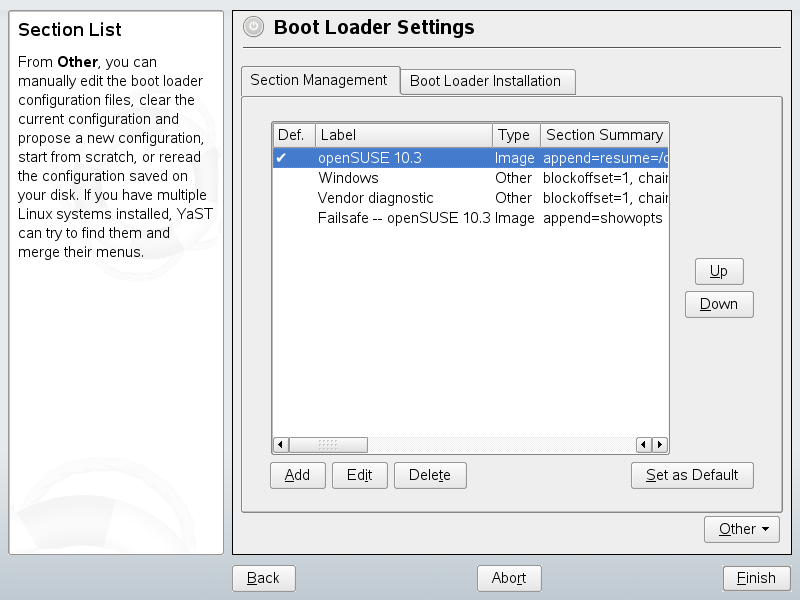13.3 Configuring the Boot Loader with YaST
The easiest way to configure the boot loader in your openSUSE system is to use the YaST module. In the YaST Control Center, select . As in Figure 13-1, this shows the current boot loader configuration of your system and allows you to make changes.
Figure 13-1 Boot Loader Settings

Use the tab to edit, change, and delete boot loader sections for the individual operating systems. To add an option, click . To change the value of an existing option, select it with the mouse and click . To remove an existing entry, select it and click . If you are not familiar with boot loader options, read Section 13.2, Booting with GRUB first.
Use the tab to view and change settings related to type, location, and advanced loader settings.
Access advanced configuration options from the drop-down menu that opens after you click on . The build-in editor lets you change the GRUB configuration files (see Section 13.2, Booting with GRUB for details). You can also delete the existing configuration and or let YaST . It is also possible to write the configuration to disk or reread the configuration from the disk. To restore the original Master Boot Record that was saved during the installation, choose .
13.3.1 Boot Loader Type
Set the boot loader type in . The default boot loader in openSUSE is GRUB. To use LILO, proceed as follows:
Changing the Boot Loader Type
-
Select the tab.
-
For , select .
-
In the dialog box that opens, select one of the following actions:
- Propose New Configuration
-
Have YaST propose a new configuration.
- Convert Current Configuration
-
Have YaST convert the current configuration. When converting the configuration, some settings may be lost.
- Start New Configuration from Scratch
-
Write a custom configuration. This action is not available during the installation of openSUSE.
- Read Configuration Saved on Disk
-
Load your own /etc/lilo.conf. This action is not available during the installation of openSUSE.
-
Click to save the changes
-
Click in the main dialog to apply the changes.
During the conversion, the old GRUB configuration is saved to disk. To use it, simply change the boot loader type back to GRUB and choose . This action is available only on an installed system.
NOTE: Custom Boot Loader
To use a boot loader other than GRUB or LILO, select . Read the documentation of your boot loader carefully before choosing this option.
13.3.2 Boot Loader Location
To change the location of the boot loader, follow these steps:
Changing the Boot Loader Location
-
Select the tab then select one of the following options for :
- Boot from Boot Partition
-
The boot sector of the /boot partition.
- Boot from Extended Partition
-
This installs the boot loader in the extended partition container.
- Boot from Master Boot Record
-
This installs the boot loader in the MBR of the first disk (according to the boot sequence preset in the BIOS).
- Boot from Root Partition
-
This installs the boot loader in the boot sector of the / partition.
- Custom Boot Partition
-
Use this option to specify the location of the boot loader manually.
-
Click to apply your changes.
13.3.3 Default System
To change the system that is booted by default, proceed as follows:
Setting the Default System
-
Open the tab.
-
Select the desired entry from the list.
-
Click .
-
Click to activate these changes.
13.3.4 Boot Loader Time-Out
The boot loader does not boot the default system immediately. During the time-out, you can select the system to boot or write some kernel parameters. To set the boot loader time-out, proceed as follows:
Changing the Boot Loader Time-Out
-
Open the tab.
-
Click .
-
Change the value of by typing in a new value, clicking the appropriate arrow key with your mouse, or by using the arrow keys on the keyboard.
-
Click .
-
Click to save the changes.
13.3.5 Security Settings
Using this YaST module, you can also set a password to protect booting. This gives you an additional level of security.
Setting a Boot Loader Password
-
Open the tab.
-
Click .
-
Set your password in .
-
Click .
-
Click to save the changes.